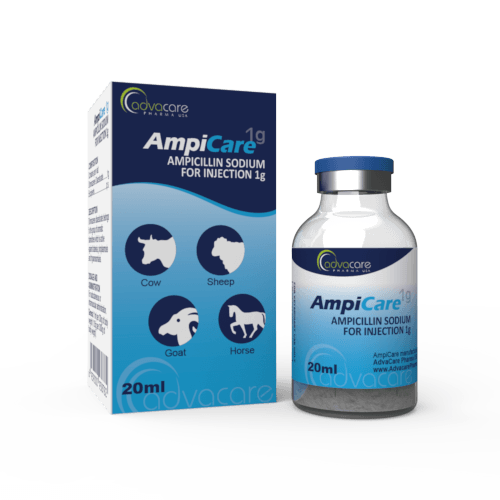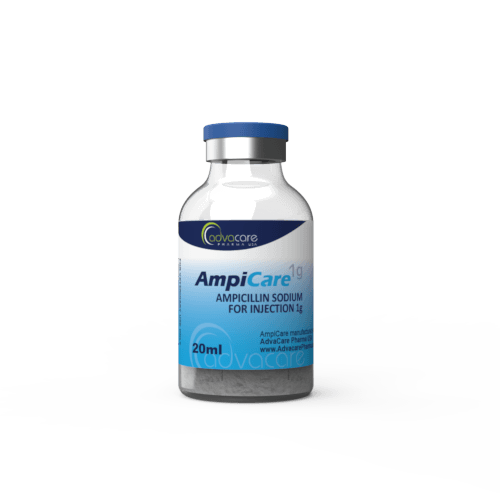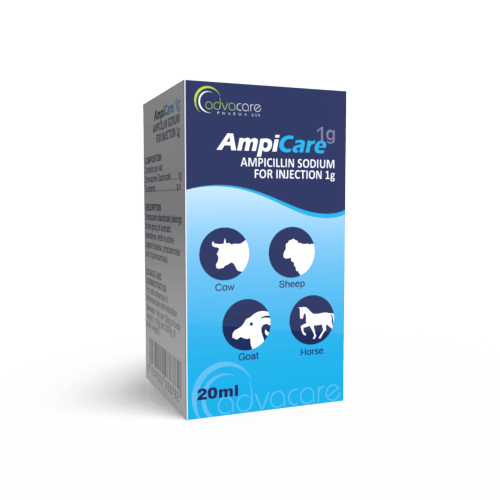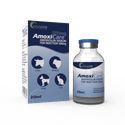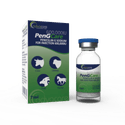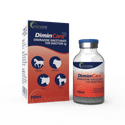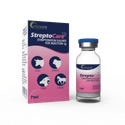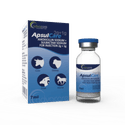- Home›
- Veterinary Pharmaceuticals›
- Veterinary Injections›
- Veterinary Powders for Injection›
- Ampicillin Sodium for Injection
Ampicillin Sodium for Injection
Dosage
Packaging
What is Ampicillin?
Active Ingredients: Ampicillin Sodium
Ampicillin Sodium for Injection is an antibiotic used to treat various types of bacterial infections in both small and large animals. It is indicated for the treatment of urinary tract infections, skin and soft tissue infections, systemic infections like sepsis, and other infections.
Ampicillin is a broad-spectrum, semisynthetic, beta-lactam penicillin antibiotic. It works by inhibiting cell wall synthesis within the bacteria. Ampicillin shows bactericidal activity against a wide range of gram-positive and gram-negative microorganisms, such as E. coli and Klebsiella. At high dosages, this antibiotic is effective against penicillin-sensitive enterococci.
Ampicillin Sodium for Injection has been produced as a fine powder that is intended to be reconstituted for parenteral injection. This antibiotic is acid-stable. It can be easily absorbed when applied parenterally. The absorption can be delayed due to the longer persistence of plasma and tissue drug concentrations. The drug is distributed through body fluids and tissues. This antibiotic does not cross the normal blood-brain, placental, mammary, or prostatic barriers (it crosses them only in cases of high doses). Animal pregnancies can increase the volume of distribution. Ampicillin is excreted unchanged, and the drug undergoes minimal metabolic transformations. Around 90% of the drug can be eliminated through urine within 6 hours due to glomerular filtration and active tubular secretion. There is also a possibility for billiar path excretion and milk in trace amounts.
It is important to note that this formulation of Ampicillin Sodium for Injection is for veterinary purposes only. While AdvaCare Pharma offers many similar products that are available for human use, this particular medication should be prescribed by a veterinary doctor or animal care specialist for an animal.
This antibiotic is also available as powder for injection with added sulbactam sodium.
Ampicillin Sodium for Injection is a GMP-certified medication that has been manufactured by AdvaCare. This medication is a part of our extensive catalog of veterinary products available for exportation. Our manufacturing facilities are located in China, India, and the USA.
Why are we a trusted Ampicillin manufacturer?
AdvaCare Pharma is a leading GMP manufacturer of Ampicillin Injection for veterinary use. Our company was established with the aim of providing excellent value to our veterinary distributors by concentrating on competitively priced, high-quality veterinary pharmaceuticals with market-tailored solutions.
Over the past 20 years, AdvaCare Pharma has proven to be a trusted Ampicillin manufacturer and supplier of 100+ veterinary injections in over 65 countries.
Uses
What is Ampicillin Sodium used for?
It is used to treat a wide range of bacterial infections such as:
- respiratory tract infections
- urinary tract infections
- skin and soft tissue infections
- bone and joint infections
- sepsis and bacteremia
- meningitis
What animals can be treated with Ampicillin Sodium?
This medicine is recommended for horses and livestock like cattle, goats, and sheep. It's also used to treat companion animals like cats and dogs. Do not use Ampicillin to treat rabbits, guinea pigs, chinchillas, hamsters, or other small mammals. It may cause enteritis or clostridial enterotoxemia in these animals.
How is Ampicillin Sodium used?
This drug has been manufactured as a powder for reconstitution. The solution is relatively unstable and should be administered to the patient within 1 hour of reconstitution.
This medication may be given through intravenous, subcutaneous, or intramuscular routes. Select the administration method depending on the present health status of the animal. Be cautious regarding sterile and aseptic conditions during drug application. If the animal's coat is excessively dirty, cleanse it before application. Use a reliable skin antiseptic like benzalkonium chloride in 70% alcohol, and refrain from applying it to dirty or infected skin.
How can Ampicillin Sodium help animals?
This antibiotic can help in treating local and systemic infections in animals. It demonstrates heightened efficacy against enterococci and gram-negative and gram-positive bacteria. Additionally, it proves effective against non-beta-lactamase-producing bacteria such as Salmonella, E. coli, Proteus mirabilis, and Shigella spp. It can also be used for treating meningitis in animals. This antibiotic acts by inhibiting the biosynthesis of cell wall mucopeptide. It is especially effective against Streptococcus spp. and Staphylococcus spp, this also includes Streptococcus equi. Most of the respiratory infections in animals are treated with Ampicillin. Abscesses and wounds can also be treated. High dosages of this antibiotic will allow the passing of the blood-brain barrier and lead to meningitis treatment.
This antibiotic is not effective against penicillinase-producing bacteria or resistant staphylococci. In some cases of Pseudomonas, Klebsiella, and Aerobacter, this antibiotic is not effective.
How can Ampicillin Sodium help in genito-urinary infections?
The predominant cause of urinary infections in animals is Staphylococci. The effectiveness of this antibiotic stems from the kidney's ability to concentrate substantial amounts of Ampicillin in the urine, resulting in a reduced impact on bacterial enzymes. In certain instances, veterinarians may enhance the treatment process by incorporating clavulanic acid to enhance the drug's efficacy against specific Staphylococcal infections. However, this antibiotic is not a good choice for patients with chronic kidney insufficiency because normal glomerular filtration is needed for proper excretion of the drug.
Can Ampicillin Sodium be used in pregnant animals?
This antibiotic stands out as one of the safest options for pregnant or lactating animals. It can traverse the mother's placenta, and it remains secure for use in animals, but there are no adverse consequences for fetuses following the administration of Ampicillin.
How successful is the treatment with Ampicillin Sodium for Injection?
The treatment's effectiveness relies on factors such as the current health status, prevailing bacteria, and the method of administration. Administering this drug through injection yields greater success compared to oral treatments with Ampicillin.
Is only Ampicillin Sodium for Injection enough to treat a disease?
This drug has bactericidal properties and can lead to fast recovery. Its effectiveness also depends on the antibiogram results. For a full recovery, some supplements and additional therapy might be needed. This antibiotic is often given for surgical prophylaxis in animals.
How should Ampicillin Sodium for Injection be stored?
This medication should be stored in a dark, dry location under 30°C.
What are the withdrawal times for Ampicillin Sodium for Injection?
For cattle, the withdrawal times are 48 hours for milk and 144 hours for slaughter. Do not treat cattle for more than 7 days. The time of withdrawal depends on the country’s regulatory requirements. It must be followed to prevent food residues and consequent public health implications.
Dosage
How much Ampicillin Sodium should be given to cattle?
For respiratory infections, 22mg/kg SC is given every 12 hours.
How much Ampicillin Sodium should be given to horses?
The usual dose is 10-50mg/kg, given 3 times per day IV/IM. For infections in foals, the usual dose is 11-30mg/kg, given every 6-8 hours IV/IM.
How much Ampicillin Sodium should be given to swine?
For infections, the usual dose is 6-8mg/kg, given every 8 hours IM/SC.
How much Ampicillin Sodium should be given to poultry?
For infections, the usual dose is 100mg/kg, given every 8 hours IM. The dose for ratites is 15-20mg/kg, given 3 times per day IM.
How much Ampicillin Sodium should be given to dogs?
The usual dose is 10-22mg/kg IM or SC, given 2-3 times per day or 5mg/kg, given 3 times per day, IV.
For urinary tract infections, 6.6mg/kg, given 4 times per day IM/SC. For sepsis, bacteremia, or neonatal sepsis, 20-40mg/kg is given every 6-8 hours IV/IM/SC.
How much Ampicillin Sodium should be given to a cat?
The usual dose is 10-20mg/kg IM or SC, given twice per day, or 5mg/kg, given 3 times per day, IV. For systemic infections, 7-11mg/kg is given every 8-12 hours IV/IM/SC. For sepsis, 20-40mg/kg is given every 6-8 hours IV.
Refer to a veterinary doctor or pharmacist for guidelines on dosage.
Side Effects
As with all pharmaceuticals, some unwanted effects can occur from the use of Ampicillin Sodium for Injection.
Some common side effects may include but are not limited to gastrointestinal effects (appetite loss, vomiting, diarrhea).
Serious side effects may include:
- allergic reaction and anaphylaxis
- thrombophlebitis (when administered IV)
- neurotoxicity during long-term, high-dose treatment (in dogs)
- gastrointestinal side effects
- organ toxicity
- superinfections
- congestive heart failure due to sodium
Ampicillin Sodium may cause pain or mild irritation when delivered intramuscularly.
For a comprehensive list of all possible side effects of this medication, consult a veterinarian.
Precautions
Do NOT use Ampicillin Sodium for Injection for an animal that: • has a known allergy or hypersensitivity to ampicillin or any other penicillin antibiotic.
The most common symptoms due to hypersensitivity are skin reactions, angioedema, drug fever, serum sickness, vasculitis, eosinophilia, and anaphylaxis.
Treatment with this drug should be administered with caution in an animal that:
- is hypersensitive to other beta-lactam antibiotics such as cephalosporins.
- is undergoing therapy with drugs such as methotrexate or warfarin.
- is pregnant or lactating.
DO NOT treat guinea pigs, chinchillas, birds, snakes, and turtles with this antibiotic.
This drug is incompatible with many other drugs and solutions and should not be mixed. A previous health history and drug intake are needed before adding this drug.
This drug can potentiate the action of anticoagulants and reduce vitamin K production by gut flora.
Ampicillin may also cause a false positive result on a urine glucose test.
What are the most common animals for which Ampicillin Sodium for Injection is used?
Ampicillin Sodium for Injection is primarily used for treating bacterial infections in companion animals and livestock. The specific common uses of Ampicillin Sodium for Injection include treatment of the following bacteria:
- Staphylococcus spp.
- Streptococcus spp.
- Trueperella (Arcanobacterium) pyogenes
- Clostridium spp.
- Escherichia coli
- Klebsiella
- Pasteurella
- Proteus
- Salmonella
- Shigella
Companion Animals Bacterial Infections
Ampicillin Sodium for Injection in companion animals is an effective antibiotic against many respiratory, skin, gastrointestinal, bone, and urine infections caused by many gram-negative or gram-positive bacteria. It can also be helpful in cases of sepsis and meningitis.
Ruminants (Cow, Goat, and Sheep) Bacterial Infections
This medication is particularly used for addressing severe infections in cows. Its application enhances the recovery process of mastitis, pneumonia, metritis, foot infections (such as foot rot), and certain skin infections.
Horse Bacterial Infections
In horses, this drug can be used for treating Streptococcus, Staphylococcus, E. coli, Salmonella, etc. It is especially recommended for respiratory infections, wounds, cellulitis, catheter-site infections, septic arthritis, and skin infections caused by Staphylococcus.
This antibiotic has widespread resistance, but a combination of beta-lactamase inhibitors and broad-spectrum penicillins can enhance the spectrum and efficacy against many gram-negative and gram-positive bacteria. The veterinarians should decide whether this combination is needed according to the current health status of the animal and the antibiogram results.

You might be interested in...
Why AdvaCare Pharma?
As an industry leader, we are aware of our responsibility to provide affordable and sustainable solutions to improve healthcare worldwide.
